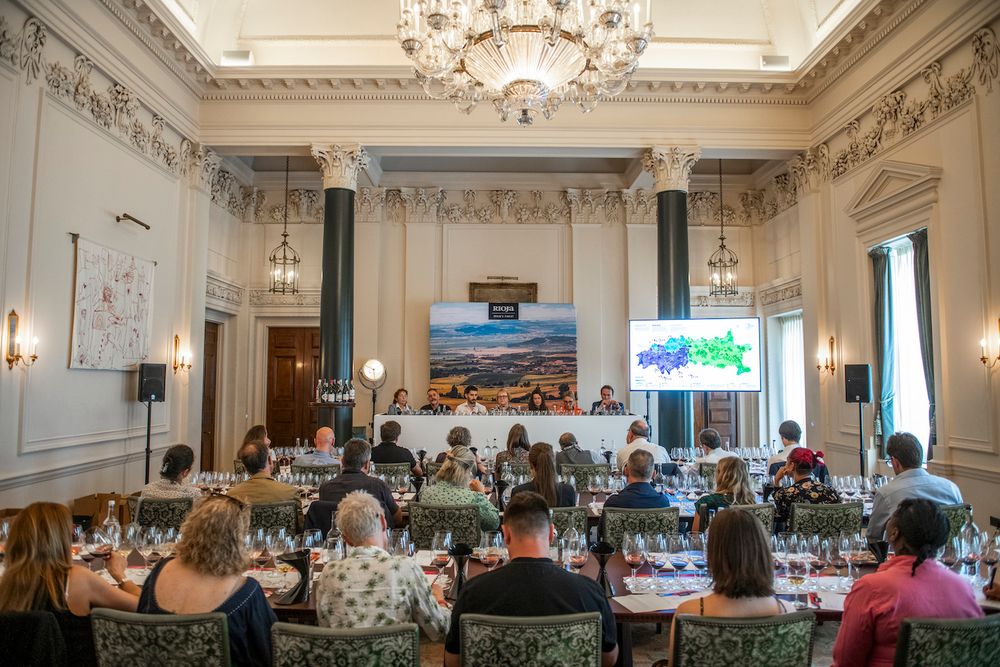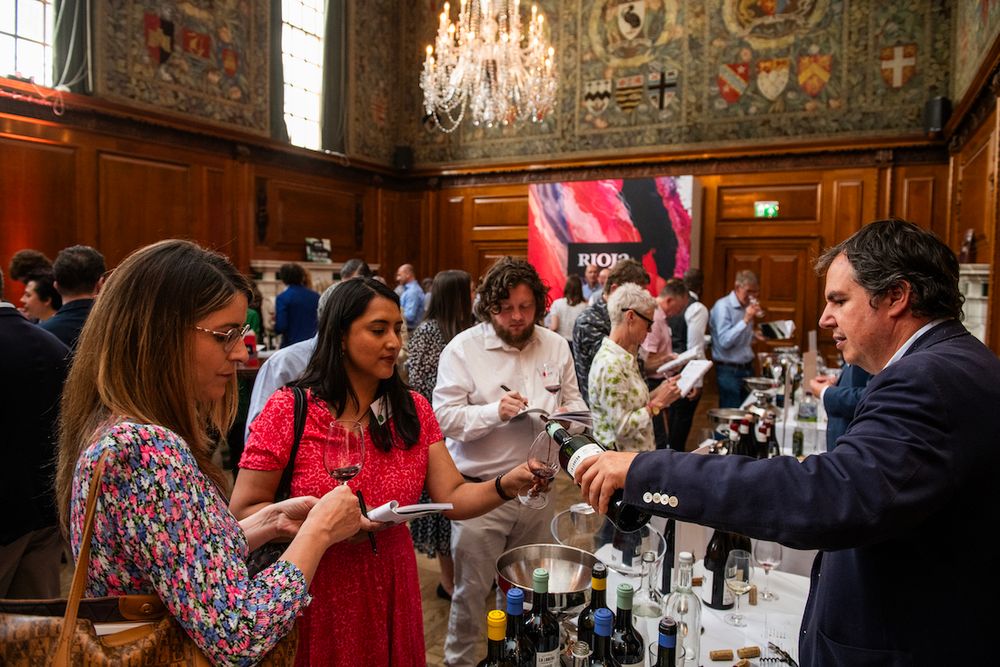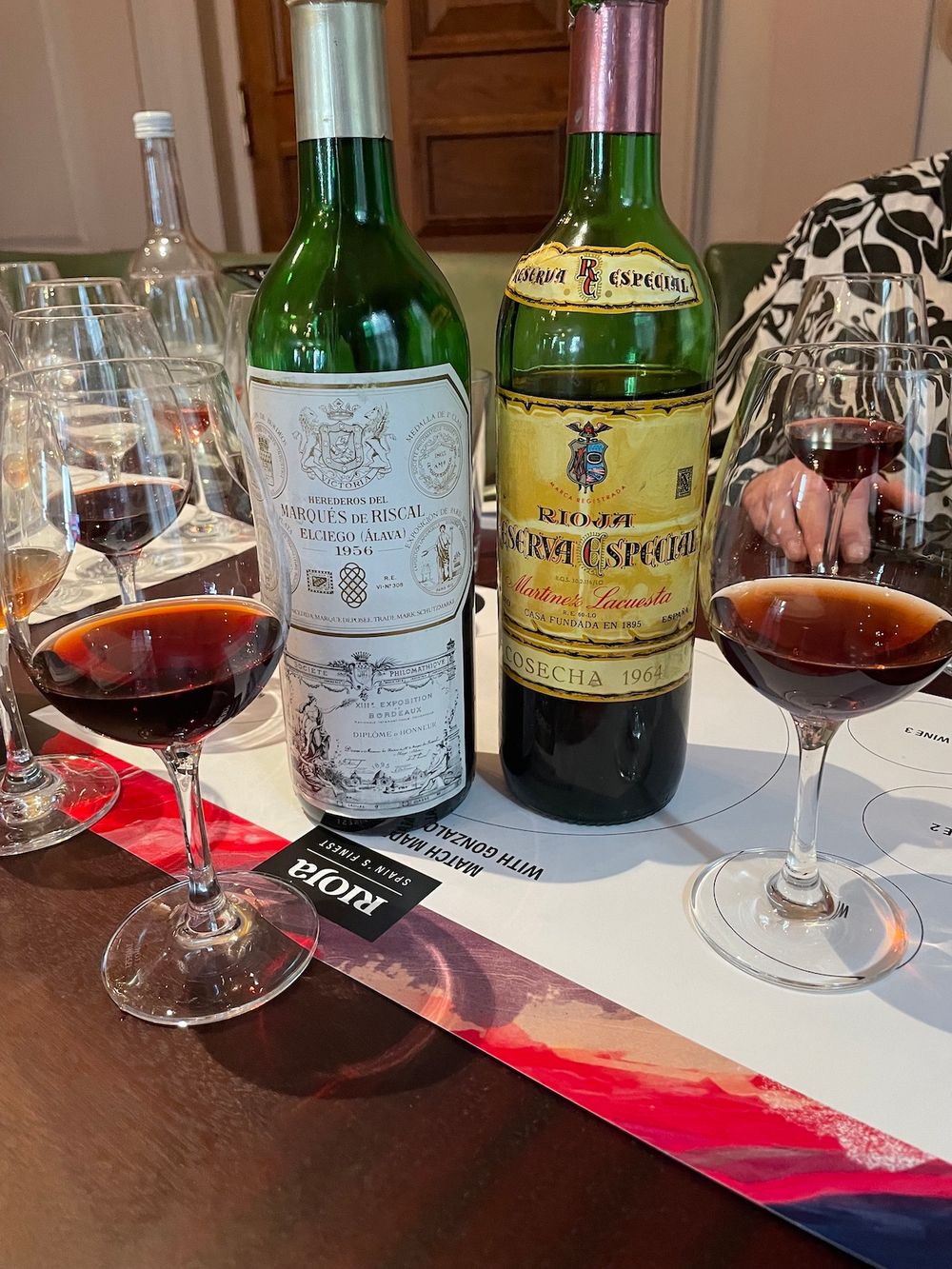“Rioja’s trump card is that it covers the traditional blended and aged styles as well as newer, more terroir-focussed wines. It’s like having Burgundy and Bordeaux in one region, and it’s one of the most exciting in Europe right now,” says Ben Lleweyln of Carte Blanche Wines at Rioja Residency.

20 of the region’s top producers were brought together for Rioja Residency, June 21, 2023
Of the top ten best-selling wines in the UK, nine are named as grape varietals and only one, Rioja, is a region. This speaks volumes about the success of the Rioja ‘brand’; for decades, Rioja has brought us well-made, well-priced, dependable bottles, and has become shorthand for those familiar, Tempranillo-based wines, characterised by their distinctive oak ageing, that we can confidently pick from a shelf knowing just what to expect.
Yet there is so much more to Rioja these days, and the region is beginning to shout about it. Last month, Rioja Wine hosted what was billed as a ‘Rioja Residency’, a ‘fully immersive day of Rioja wine… aimed at inspiring and educating key members of the trade and establishing Rioja as a super-premium, must-list fine wine’ at the swanky Ned Hotel in the City.
Twenty of the region’s producers were brought together to showcase their top cuveés and old vintages. They came from across the three main areas – the most northerly and Atlantic-influenced Riojas Alta and Alavesa, and the less well-known, more remote Rioja Oriental, spreading towards the Mediterranean influences to the east – and included established institutions such as Ramón Bilbao, Marqués de Cáceres and Marqués de Murrieta alongside smaller, lesser-known producers who were showing a move away from the traditions of the region and pushing the boundaries of what Rioja can achieve.

Full house: one of the many seminars held throughout the day
Many of these winemakers were breaking free from the established crianza/reserva/gran reserva rules that stipulate, among other things, the wine must be aged in new (usually American) 225-litre barriques and nothing else. These days, a new generation of winemakers are employing alternatives with which to ferment and age their wines, including large-format foudres, concrete and clay, as well as techniques and grapes that are new or underused in their region, to make some very interesting wines, more expressive of their terroirs and their makers’ personalities than the familiar Riojas of yore.
Rioja’s classification changes of 2017 expanded on the region’s primary indicator of quality being the regimented oak-ageing regimes. The Consejo Regulator DOCa Rioja now also recognises the diversity and quality that the particular soils and microclimates of specific municipalities and vineyards can bring to the wines, and allows makers to name them on labels. The details of these new Vinos de Zona are long and complicated (those interested can read our very own Mike Turner’s thorough 4-part coverage here), and it was an issue not much discussed at the Rioja Residency perhaps for that very reason.
“The most important influence on these terroir-driven wines is the people behind them,” said Sarah Jane Evans MW, the UK’s ‘Queen of Spanish Wine’, who led the first of the day’s masterclasses titled ’10 Hero Wine Styles of Rioja’, accompanied by winemakers and representatives of the ten wines shown. ‘100 Kilometres of Diversity’ shouted the strapline for the event, and diversity was what we got.
“Alta and Alavesa are completely different from Rioja Oriental,” Evans said. “Oriental is not as well-known but is really exciting right now. Historically it’s been dominated by co-ops but more and more growers are beginning to make their own wine, plus now there is room for a younger generation to come in to buy land.” Rioja Oriental was hit hard by decades of rural depopulation in the face of a modernising Spain, so land, often including plots of abandoned vines, are more affordable here than elsewhere in the region.
“To be honest, I’d struggle to identify some of these wines as Riojas,” she went on. “Across the whole of the region, the straightjacket of the reserva system has been shrugged off and that’s very liberating for winemakers.”
White Rioja and rosados

Rioja Residency also gave importers an opportunity to highlight new styles of wine
There were some fine red Riojas, of course: very serious, traditional wines as well as those of a more contemporary nature, but those that really caught my eye were the foursome of whites and rosés. Clarete! A Tempranillo Blanco! Skin contact! Amphorae ageing!
“The story of white Rioja has been a rollercoaster,” said Antonio Salinas of Real Agrado in Rioja Oriental. “Many white vines were grubbed up in the early 2000s and growers increased plantings of red varieties, but that’s changing and now white and rosé are the fastest sectors of the Rioja market.”
More appeared at a food and wine pairing masterclass later led by Gonzalo Rodriguez Diaz, who has St John, Azurmendi and Theo Randall on his sommelier’s CV and now resides at La Dame de Pic in London. He agrees with Evans. “The style and personalities behind these wines are more important than their classified regions. So many young people are now doing some really interesting, exciting things,” he said, adding with a wink “although sometimes they’re just reinventing the wheel.”
Ben Lleweyln of Carte Blanche Wines was here showing one of the star wineries of the day, Arizcuren Bodega Y Viñedos with grapes from Rioja Oriental.
“Most somms and wine shops find Rioja confusing and boring, unless it’s Tondonia or José Gil,” he said. “But when I take people there, they invariably become evangelists. Rioja’s trump card is that it covers the traditional blended and aged styles as well as newer, more terroir-focussed wines. It’s like having Burgundy and Bordeaux in one region, and it’s one of the most exciting in Europe right now.” I concur.
The day concluded with a party, fuelled by sparkling Rioja, canapés and live music, on the sunny terrace of the Ned’s fifth floor. Sadly, I had to leave before the fun started, but I left pleased that I’d been there. The Rioja Residency had been interesting and tantalising, leaving me wanting to explore the region’s new generation further. I’d like to have seen more of the new upcoming styles and makers, but it would be churlish to complain about tasting many top-class traditional wines such as Marqués de Murrieta’s Castillo Ygay 2011 Gran Reserva as well. That wine is imported by Maisons Marques et Domaines with a RRP of £250, should you be in the mood.
Rioja wine highlights of the day

Whites and rosados rubbed shoulders with crianzas and gran reservas
ARIZCUREN BODEGA Y VIÑEDOS, SOLOMAZUELO ÁNFORA 2021
100% Mazuelo, ABV: 15%, Importer: Carte Blanche Wines, RRP: £41.00
It’s typical of Carte Blanche’s Ben Llewelyn to choose to list this maker, who Sarah Jane Evans described to me as “super-super interesting”. Javier Arizcuren comes from a family of growers in Quel in Rioja Oriental but trained and practiced as an architect before turning to winemaking. In 2016 he designed and built his own urban winery in the heart of Logrono, Rioja’s capital town, which he runs alongside his architectural practice. Sourcing the best fruit from his family’s organic estate on the slopes of Mount Yerga, from vines that are up to 120 years old, Javier makes modern, focused wines of incredible finesse. He produced only 600 bottles of this wine. Mazuelo grapes (the local name for Carignan) were fermented in stainless steel tanks then sent to unlined earthenware amphorae for 8 months. Clear, mellow autumnal fruit sings out alongside a savoury, textured earthiness while dancing very dainty on its 15% abv feet.
DOMINIO DE QUEIRON, ENSAYOS CAPITALES 2019
100% Tempranillo Blanco, ABV: 12.5%, Importer: Boutinot Ltd, RRP: £30
Two brothers and a sister are the fourth generation of the Pérez Cuevas winemaking family in the remote Quel region of Rioja Oriental at altitudes between 600 and 1600 metres. Committed to restoring old vineyards, they work organically, encouraging biodiversity and improving the soil health.
Tempranillo Blanco was discovered in 1988, the result of a natural genetic mutation of the red variety, and was authorised by the DOC in 2008. Winemaker Rubén teases out its floral, fruity charms to make a really complex, captivating wine. Cold maceration is followed by fermentation on the skins for a week then the wine is transferred to 500-litre French oak barrels to finish the fermentation then to amphorae for a year.
A rich, almost smoky nose with ripe apricot fruit and a little spice. Luscious and textured with just a gentle grip and a long, saline finish.
220 CANTARAS, HONORIO RUBIO LIAS FINAS ROSADO 2020
60% Garnacha, 30% Viura, ABV: 13.5%, Importer: Les Caves de Pyrene, RRP: £25-30
Honorio Rubio is known as a maverick and visionary winemaker, working at high altitudes in Rioja Alta. This is a revival of the traditional clarete rosados that were commonly made here in the past where the Garnacha and Viura are grown and vinified together.
Here he uses a mix of 225, 500 and 600-litre used barrels to age the wine for 16 months. A stunning wine bursting with energy and with lots going on – pure red fruit, tangerine zest, astringent herbs, a touch of nutmeg. One of my favourite wines of the day and one I really want to taste again without spitting it out.
220 CANTARAS, AÑADAS EDICIÓN LIMITADA NV
100% Viura, ABV: 13.5%, Importer: Les Caves de Pyrene, RRP: £35-40
This is an extraordinary wine, another made by Honorio Rubio, who treats the traditional white grape of the region to the ageing process of sherry. Although not fermented under flor, this is aged in a solera system whereby 30% of the oldest barrel is bottled then topped up with younger wines aged on their lees in a mix of American oak, French oak and acacia.
Now containing a blend of 15 vintages, this is really intense, like a sherry, and just as appetising; oxidative but still fresh with layers of orange peel, warm spice and salted nuts.
SIERRA DE TOLOÑO, NAHIKUN BLANCO 2021
Viura, Malvasia and old varieties, ABV: 12.5%, Importer: Lea & Sandeman, RRP: £26.45
Sandra Bravo is a native of Rioja but not from a winemaking family. She studied winemaking in Bordeaux and Rioja then worked in New Zealand, Tuscany and California before acquiring 9.5 hectares of 80+-year-old vines at 650m in Rioja Alavesa, and she was a founder member of Rioja ’n’ Roll, an unofficial association of forward-thinking young winemakers established in 2016.
She farms biodynamically and ferments with ambient yeasts, making this brisk, refreshing wine with zingy, grapefruit fruit, a whiff of white flowers and a lovely herbaceous minerality.
ALONSO & PEDRAJO, LA PEQUEÑITA MACERADO MATURANA BLANCA 2019
100% Maturana Blanca, ABV: 14%, Importer: Les Caves De Pyrene, RRP: £35-40
Also members of the Rioja ’n’ Roll collective are Javier Alonso and Alberto Pedrajo who, along with their partners, specialise in minimum-intervention wines, often made with unusual, misunderstood grapes, aged in old tinajas (amphorae) and used barrels.
This 100% Maturana Blanca has 100 days skin contact in old tinajas followed by ageing in used 500-litre barrels for 6 months. A concentrated, peach-nectar nose with quince-like, bruised-apple fruit and a satisfying tannic crunch. Wild and wonderful.
AKUTAIN GRAN RESERVA ROSADO 2016
Variety: 100% Tempranillo, ABV: 14%, Importer: Vine Trail, RRP: £80-85
This bodega was established in the 1970s by Juan Peñagaricano Akutain, a former salesman of cooling units sold to top bodegas from who he learnt how to make wine. He planted his first vineyard 5kms west of Haro in Rioja Alta and built his winery in an adjacent old barn. Now run by his son and nephews, they produce wines in traditional styles but with the distinctive fingerprint of their wind-swept, 600m location.
A wine that is only made in the best vintages, and in tiny quantities – 600 bottles of this were released. It’s made by the saignée method, a byproduct of wine that goes on to make reserve and gran reserve reds, fermented in fibreglass then transferred to two old barrels, one French, one American oak, for 52 months before finishing in newer barrels. Proudly unfashionable with its dark pink colour, there is much going on here: raspberries, cherries, almonds and orange peel underpinned with savoury, earthy notes of cloves and tobacco, wrapped into a gorgeous silky texture.

1956 and 1964 vintages were shown during one masterclass at Rioja Residency
And finally….
All in all the Rioja Residency was a fascinating day. And I leave the final word to Iñigo Tapiador Rioja DOCa’s global marketing and communications director: “It is wonderful to be able to show some of Rioja’s best wines to the trade in the UK and also to work with some of the region’s most impassioned and knowledgeable experts; Sarah Jane Evans, Pedro Ballesteros Torres and Gonzalo Rodriguez Diaz – who really brought the region to life, together with the many participating wineries, importers, and trade guests. It is a true celebration of Spain’s finest region.”
































